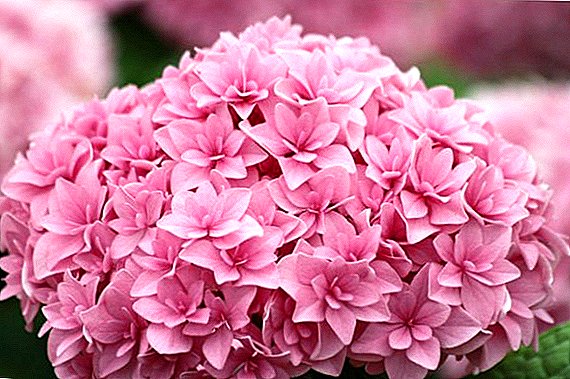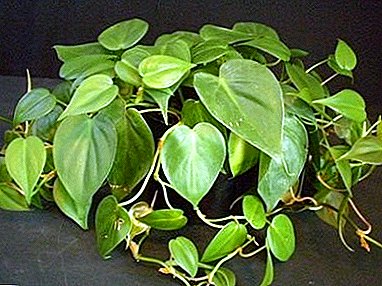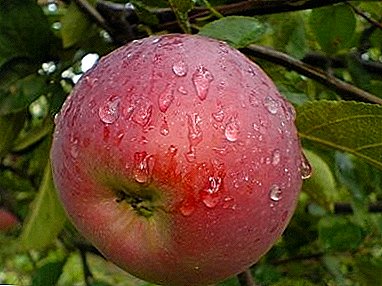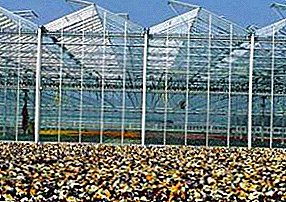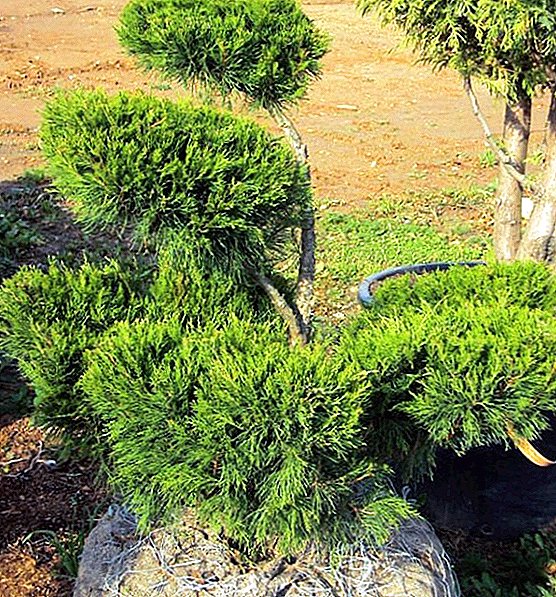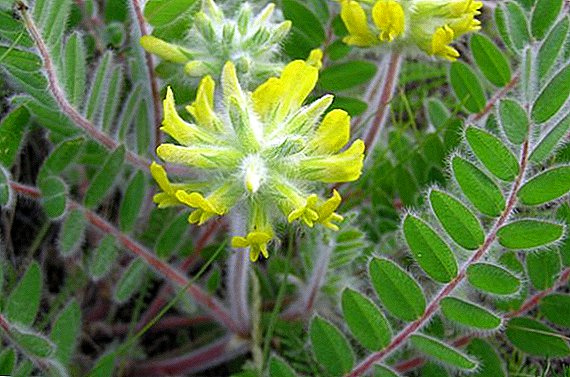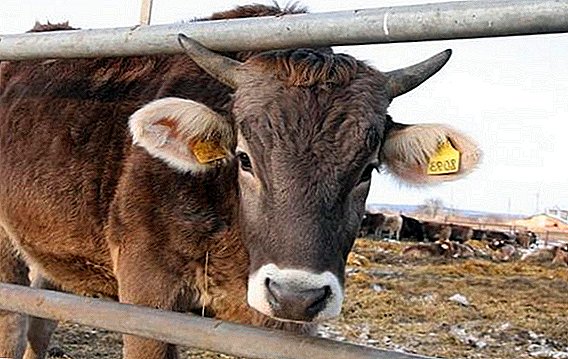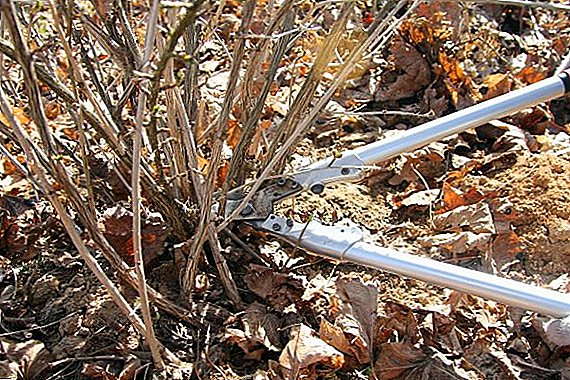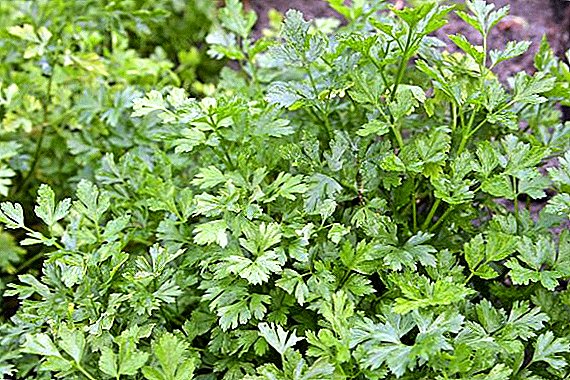 Every gardener wants to get a bountiful and high-quality harvest, but not always it turns out. Often vegetables are attacked by pests or affected by disease.
Every gardener wants to get a bountiful and high-quality harvest, but not always it turns out. Often vegetables are attacked by pests or affected by disease.
The crop suffers from these misfortunes, so you need to be guided in the causes of garden problems and be able to take measures to solve them.
Causes of yellow parsley in open ground
When growing parsley can be faced with the problem of its yellowing.

This may be due to various factors:
- lack of moisture or nutrients;
- the occurrence of diseases;
- pest damage.
Let us examine in more detail the last two points.
Description of common parsley diseases
Many parsley diseases are characterized by similar symptoms, so it can be difficult to identify the disease. Consider the features of the most common.
Did you know? F. Miller in his "The Gardener's Dictionary" (1805) called parsley "the killer of small birds." It also said that it harms eyesight and provokes epilepsy.
Mealy dew
A common fungal disease that affects all parts of a plant.
Its main symptoms are:
- characterized by the appearance of white plaque, which is a superficial mycelium;
- the formation of fruit bodies, changes the color of the mycelium, it becomes dark gray;
- propagated by conidial sporulation;
- source of infection are the remnants of infected plants.
 Powdery mildew is caused by the fungus Erysiphe umbelliferarum.
Powdery mildew is caused by the fungus Erysiphe umbelliferarum.
Stolbur
Phytoplasma is the causative agent, and carry its cicadas.
You can determine by the following features:
- characterized by chlorosis, which manifests itself initially on the edge of the leaf blade;
- the whole leaf is gradually affected;
- the affected area eventually becomes red;
- the plant lags behind in development, and later dries out;
- the first symptoms of the disease appear approximately one month after infection, this happens at the end of July or the beginning of August;
- the pathogen remains in carrier larvae hibernating on the roots of weeds and cultivated plants;
- the prevalence of the disease depends on the migration of tsikadok.

Septoria, or white spot
Pathology has a fungal origin and is recognized by characteristic features:
- yellow-brown stains on any parts (leaves or stems) of the plant;
- later, the color of the spots changes to off-white with a dark brown edging;
- in the later stages of the lesion, the parsley turns yellow and dries;
- a favorable condition is a humid environment;
- spores persist in plant residues.

Rust
Symptoms include:
- the first signs appear at the beginning of summer;
- spots (with a diameter of about 0.5 mm) yellow-brown color on the back of the sheet plate;
- spotting can be scattered or group;
- further stem part and stem are affected;
- the lesion acquires a brown color and becomes powder;
- the culture turns yellow and loses its taste;
- on the remains of plants, the teliospores, which germinate in basidium, are preserved. Primary infection occurs through basidiospores.
 The cause is infection with the fungus Puccinia petroselini Lindr.
The cause is infection with the fungus Puccinia petroselini Lindr.
Jaundice
Jaundice is viral in nature. It spreads to many cultures and is spread by smiles.
Symptoms of the disease are:
- yellowing leaf veins;
- excessive branching of the stems;
- root roots form secondary roots resembling felt;
- winters in the juice of perennial plants.

Bright dwarfism
Another viral disease, which is carried by aphid. Pathology is rarely found in parsley.
Its main symptoms are:
- at the stage of 3-4 sheets arises the curvature and shortening of the leaf stem;
- leaves become small and covered with chlorosis in the form of a mosaic of dark and light areas;
- deformation and twisting of the leaves are observed;
- redness may be observed along the edges of chlorosis.

Spotted bacteriosis
The disease caused by bacteria has the following symptoms:
- leaves are covered with light spots;
- over time, the spotting darkens;
- the foliage becomes covered with slime and is showered.

Fomoz
Dry brown rot can develop in 2 forms.
The following symptoms are observed on a green plant:
- dark stripes and purple spots appear at the base of the petioles and at the branching points;
- quite often a sticky mass is formed on the spots;
- later, the affected areas become gray, dry out and become fragile;
- affected parts of plants die off;
- distribution occurs through plant debris and seeds;
- the bushes growing next are also the first to become infected, but the disease quickly spreads and covers large areas;
- pathology is observed at the end of summer - the beginning of autumn, practically at the end of the growing season;
- favorable conditions - high humidity.

The second form of fomoz - root rot, which is already observed in the vaults. Vegetables are covered with gray depressed spots, under which a brown rotting fabric is formed. The presentation and taste of products deteriorate dramatically. Also reduces the shelf life of root crops.
Did you know? Parsley was used not only for treatment or cooking. The Greeks wove her into funeral wreaths and garlands of winners of sports competitions. And the Romans wore such wreaths to prevent intoxication during the holidays.
Perinosporosis
Its characteristic features are:
- the upper part of the leaves is stained with chlorosis;
- spotting acquires a light yellow color, angularity and oiliness;
- later, the spots become brown, and their underside is covered with a touch of gray-purple color;
- the affected foliage dries out, and the bushes are stunted;
- the disease progresses in wet weather with a temperature of about + 15 ... + 20 ° С;
- The source of contamination is the remains of the affected parsley.
 Downy mildew is a fungal disease.
Downy mildew is a fungal disease.
Description of parsley pests
In addition to diseases, parsley is attacked by pests. Let's name the most common.
Carrot listobloshka
These light green small insects have the following harmful effects:
- plant sap serves as food for both adult specimens and their larvae;
- leaves are deformed and curled;
- sheet rosette acquires terry;
- later the foliage withers and falls;
- root tissues become hard, lose their taste and juiciness.

Stem Nematode
This pest is often found in onions and garlic, but it affects parsley as well.
Nematode and its larvae feed on the juice of spicy culture, causing disturbances in its development:
- leaves turn yellow and die;
- bushes are stunted;
- white filiform worms multiply by laying off larvae in plant tissues. When the bushes die off, the larvae go to the ground to search for a new vegetable crop.

Carrot fly
It is a small (up to 5 mm) insect, with a belly black with a greenish tint, yellow paws and a yellow-brown head.
It affects almost all umbrella cultures:
- at the end of May lays eggs at the roots;
- the larvae penetrate the root system, damaging it with a multitude of moves, later pupating into the ground;
- In the middle of summer, the second generation of insects appears, and everything repeats. These larvae, pupated, winter in the ground;
- corroded root crops become woody and become unsuitable for storage, and the leaves gradually acquire a reddish-purple hue, turn yellow and dry out;
- the fly prefers highly moist areas.

Gourd Aphid
This insect affects not only melons and gourds, but also parsley. It has a small size (1.2-1.8 mm) and color from yellow to almost black.
Its larvae and adult representatives, being on the inner surface of the leaf, feed on its juice.
The danger of a pest is that insects:
- sucking the sap from plants causes its withering, yellowing and death;
- having overwintering in the open ground (on the remains of weeds or cultivated plants), starting from May to the end of the growing season, form more than 10 generations;
- are carriers of various infections.

Ways to combat diseases and pests
In order to combat pests and diseases using traditional methods of treatment or chemical drugs.
Folk methods
With the defeat of parsley tley apply the following folk remedies:
- in the heat should spray the bushes with water;
- instead of water, you can use the infusion of garlic, tomato or potato tops, onion peel, tansy or wormwood. For an infusion take about 400 g of any of the listed ingredients and pour a bucket of boiling water. Insist day, after which add 40 g of soap. Spend 2-3 treatments with an interval of 4 days;
- if the aphids are not very much, you can spray parsley with soapy water (40 g per bucket of water);
- golden-eyed and ladybugs reduce the number of aphids.
Important! Marigold, coriander, mint, garlic or basil planted next to parsley will prevent the appearance and reproduction of many pests.
In the fight against carrot fly apply:
- a mixture of sand with naphthalene (9: 1) is scattered in the beds during planting;
- inter-row sprinkled with wood ash or black pepper;
- the onions planted nearby discourage the harmful insect.

It is difficult to get rid of carrots with the help of folk methods.
You can try the following tools:
- process tobacco dust;
- spray with soapy water (40 g per bucket of water);
- collect and destroy insect eggs.
To combat the stem nematode, you can use the following infusions:
- Grind 1 kg of calendula and pour a bucket of warm water, insist 2 days and apply for watering or spraying.
- For the preparation of onion brew take 0.5 kg of onion, pour a bucket of water and insist day. Water about 3 times with a week break.
- Take 300 g of flowers and leaves of nasturtium, pour 5 liters of water, insist day. Use for watering, as well as the previous infusion.
We recommend to learn how to plant parsley for rapid growth.
Folk remedies in the fight against parsley diseases are ineffective, but you can still try:
- When powdery mildew can spray the bushes with a solution of 1 tbsp. l soda with 0.5 tsp. liquid soap to 4 liters of water. To process about 3 times with a week interval. Or prepare a solution of whey, diluted with water in a ratio of 1:10.
- When infected with powdery mildew (peronosporosis), a serum solution (3 l) + 1 tsp is used. copper sulphate in 7 liters of water. Parsley should be treated with this agent.
- Rust damage will prevent moderate watering.
 Note! To reduce the likelihood of disease, it is important to alternate the cultivation of parsley with tomatoes, legumes and beets.
Note! To reduce the likelihood of disease, it is important to alternate the cultivation of parsley with tomatoes, legumes and beets.
Chemical processing
For various diseases used chemicals:
- with septoria The treatment is carried out with "Energen" (20 drops per 1 l of water) at the beginning of July, and then repeated after 10 days. You can also use "Profit" according to the instructions;
- from septoria 2-time treatment of young plants with 0.5% copper oxide or 1% copper sulfate solution will help (the interval in treatments is about 3 weeks);
- when symptoms of spotted bacteriosis appear, drugs such as Planriz or TMTD are used in accordance with the instructions;
- double treatment with 1% bordeaux liquid (with a break of 10 days) is carried out with symptoms of fomoz;
- with rust fungicides "Topaz", "Baktofit", "Fitosporin-M" according to the instructions. The first treatment is carried out when symptoms are detected, and repeated - in 1-2 weeks;
- with powdery mildew symptoms the fungicides “Bayleton” or “Fundazol” are used according to the package annotation.
Important! When treating plants with chemicals you need to remember that such greens should not be eaten. It is necessary to carefully read the instructions to know when parsley can be used.
Chemistry is also practiced in carrot pest control:
- in the fight against aphids effective drugs such as "Fitoverm-1" (5 ml per 5 liters of water), Spark (1 tablet per 10 liters of warm water), Karbofos (60 g per 10 liters of water), as well as ground sulfur pollination. After processing the plant, it is desirable to cover the film for a day, this will help to destroy all pests;
- listobloshka destroyed when spraying preparations "Spark" or "Fitoverm". The first treatment is carried out in May (the mass appearance of the pest), and the second in June (the appearance of the larvae). Listobloshki overwinter on coniferous plants, so it is advisable to process them (early spring and late autumn) "Karbofos" (60 g per 10 liters of water);
- to fight the carrot fly Chemicals such as Inta-Vir, Decis or Vega are used. Treatments are carried out in May (laying period);
- products containing mercaptophos or phosphamide are used in the fight against nematode. Such preparations are "BI-58", "Dimethoat" and "Rogor". Before use, you must read the annotation.
Video: Biological preparations for plant protection from pests and diseases
Preventive measures
To parsley pleased with their appearance, was tasty and was not affected by pests and diseases, you need to practice preventive measures:
- sow resistant varieties (Fresco, Natalka, Titan or Element);
- use only healthy and high-quality seed for sowing;
- conduct seed disinfection. To this end, they are soaked in warm (+ 45 ... + 48 ° C) water for 20 minutes. You can also apply a 1.5% solution of potassium permanganate (soak for 20 minutes and rinse with water);
- planted in well-drained soil, in aerated beds away from coniferous crops;
- adhere to the crop rotation (alternate with tomatoes, beets or legumes) and place in the same place not earlier than in 3 years;
- planted after tomatoes, cabbage, cucumbers or peas;
- destroy weeds and plant residues (pathogens of many diseases may persist);
- fertilize with potash and phosphorus dressings. Acidic soils chill;
- thin out thick crops (in phase 2 of these sheets);
- timely weeding and loosening;
- root crops are harvested when the temperature drops to + 5 ° C.



